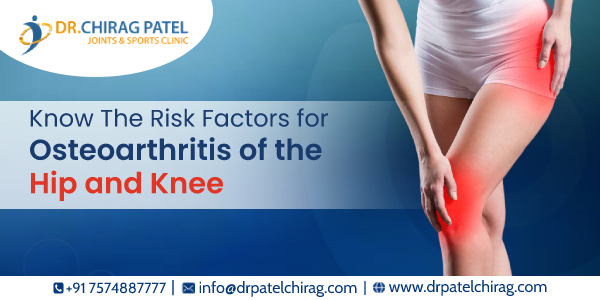No other medical condition can dampen the quality of life as much as hip and knee osteoarthritis does. And why not? Given their major weight-bearing joints, any injury to the hip and knee can be a bane to existence in old age.
Pain, stiffness, tenderness, swelling and loss of flexibility can make life uncomfortable every day. The lack of a permanent non-surgical treatment option is not going to help either. One can only delay the onset and mitigate the severity of symptoms by knowing the risk factors and taking preventive steps as early as possible.
In today’s blog with inputs from the best ortho doctor in Mumbai, we have put together a list of risk factors for both osteoarthritis of the hip and knee for your awareness. Read on to know them:
Risk Factors for Knee and Hip Osteoarthritis:
Though osteoarthritis is common among adults, it is no straightforward disease. Its severity and incidence can vary from person to person based on a variety of factors. Osteoarthritis is a combination of local factors like injury or trauma and systematic factors like worn-out joints due to ageing. So whether knee or hip both the risk factors are in a way similar to each other, which are as follows:
- Age and sex: Naturally the risk of osteoarthritis increases with age, but women in general are more likely to develop arthritis than men.
- Obesity: By far the second most major risk factor when it comes to osteoarthritis. Every pound of extra weight translates to 4 pounds of additional stress on the weight-bearing joints like hips and knees. In addition to this, the fat tissue causes additional inflammation around the joints further aggravating the osteoarthritis condition.
- Injuries and trauma: Injuries to hip and knee joints from accidents or sports are found to accelerate the onset of arthritis. “Injuries that occurred and healed many years ago can also trigger arthritis”, says an orthopaedic doctor in Mumbai Dr Chirag Patel.
- Bone deformities: Few people are born with improper bone alignment between the hip and socket, and few others may have been born with defective cartilage at the knee joint – cases like this can increase the chance of osteoarthritis too.
- Genetic factors: 60% of osteoarthritis cases are found to be influenced by genetics – more in the case of hip osteoarthritis. Particularly, maternal genes tend to impact the onset of osteoarthritis. Congenital hip dislocation, hip dysplasia, and Femoroacetabular dislocation are some of the conditions that are widely influenced by genetic factors.
- Metabolic diseases: Metabolic conditions like Diabetes or hemochromatosis can also increase the risk of developing osteoarthritis of the hip and knee.
How to Cut Down the Risk of Hip and Knee Osteoarthritis?
With the right care, one can always delay the onset of arthritis and drastically cut down the risk of symptoms. In the above 6 risk factors except for genetics and congenital bone deformities, other factors can be mitigated by making healthy lifestyle changes.
A well-balanced diet, regular activity with a tight exercise regimen, avoiding smoking and cutting down on alcohol can improve bone health and reduce the risk of osteoarthritis significantly. That said if you are already suffering from hip or knee osteoarthritis, they can also be managed with the right treatment from a hip and knee specialist. If you are in Mumbai, you can contact orthopaedic specialist, and hip and knee surgeon Dr Chirag Patel .





